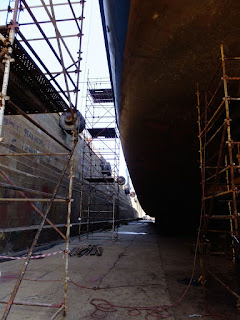This year's plans were to go into dry dock in early June, finish shipyard repairs with the ship in the water in July, and happily sail back to Madagascar at the beginning of August. Thanks to unforeseen events and challenging repairs to the propellor shaft and chain locker, instead we are still sitting in dry dock and hoping, nay, praying that putting the ship back into the water tomorrow will be a smooth event.
For those of us with hospital jobs, one of the things we seem to automatically dwell on is the patients we won't get to see. Every day of delay is more people in need that we will never get to meet or help. Every week of delay is a tragedy that plays out in our heads as we tally the numbers.
In truth, we try not to focus on the negatives. A few extra weeks here has allowed all the repairs to be completed, which is a blessing. It also means extra time for planning and figuring out details that might not be priorities if we didn't have the time. The kind of details that make our quality and standards rise in the hospital. Things like policy and procedure revisions, adding to the manuals that include detailed descriptions of the surgeries done on board, and discussing new and better ways to accomplish things in the hospital.
It also gives us time to fall to our knees in prayer. Because truly, how often do we forget who is really in charge of all things? We start to believe that we might be able to make plans without God's help. As we have dealt with changes again and again to how much longer we will be here and whether we can get the right parts in a timely manner, we have found ourselves in deep and fervent prayer for swift and safe solutions.
It is just possible that the discomfort of living in dry dock is the kind of thing that brings us to our knees that much faster. What discomfort? Well... in dry dock we need to rely on electricity from the shore and pay heavily for every bit of water waste that needs to be pumped off the ship. Water and electricity restrictions mean things like: No air-conditioning, hallways that aren't lighted, laundry and shower restrictions, paper plates for one to two meals a day, no hot food at lunch, only one stove available in the crew galley. Dry dock is considered a construction zone, which results in the requirement of wearing a hardhat whenever we leave the ship, and the families are all required to be off-ship until we're back in the water. No families makes this a much more quiet, somewhat more serious place.
The lack of air-conditioning means my cabin gets to a blistering 32.5C at night when I'm trying to sleep. I will be so very thankful for air-conditioning once it is turned on again!
On the plus side, beyond the extra work we're getting done, I have had the chance to do a little exploring, going to the local aquarium and to a game park just outside of town. We've made the most of it and had fun, but I am really, really looking forward to getting this ship moving and back to Madagascar! Hopefully arriving before September!
Here's dry dock in picture format! Captain Jurian was kind enough to give regular tours around the bottom of the ship!
The wall that holds the water back! It's at the aft (or back) of the ship).
Notice what's missing? The left propellor! This is just before they removed the left rudder in order to pull the propellor shaft out for repairs. (It is all back together already, this picture is two weeks old!)
The stairs to get down to the dry dock area!
Some of the cranes that surround the area where the ship is. They are all on rail tracks to move big equipment around.
Another view of the missing propellor
Port side of the ship. You can see the back-up emergency exit, that involves scaffolding and ladders. I'm very thankful to never have climbed down it!
Pieces of propellor waiting to go get worked on.
This is what holds the ship up. They are all placed according the the original ship manufacturers's diagrams of how to place them and at what angle. They are placed before the ship is brought in, and it gets settled on them very carefully while being held in place by strong ropes until the water is all drained front the dry dock area.
This is midway down the ship on the port side looking towards the aft.
Some of the many water intake grills. These let water for cooling systems in, and need to be cleaned regularly by our wonderful ship divers. (it's not an official job, just an extra duty that people with diving experience can sign up for)
Bow thrusters. They let us move sideways away from the dock!
That's how much dry dock is left in front of the ship... we're pretty small compared to the size of ships that they can bring in here! It's one of the largest dry docks in the world!
This is the bow of the ship!
Here she is, sitting out of the water!
The gangway back on to the ship. Sturdy and safe. I'm very, very thankful not to have to climb 5 or 7 decks worth of steps like in some dry docks!















No comments:
Post a Comment